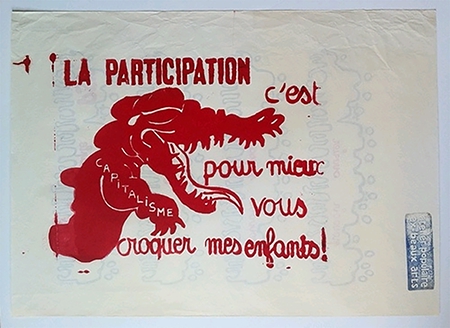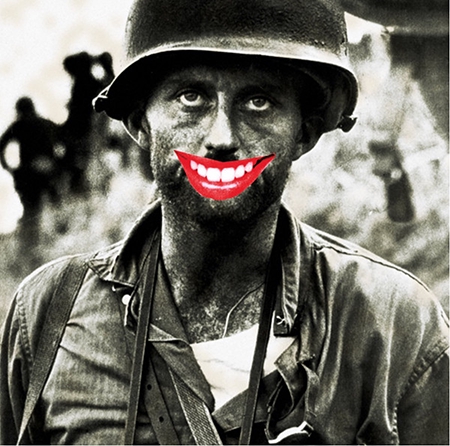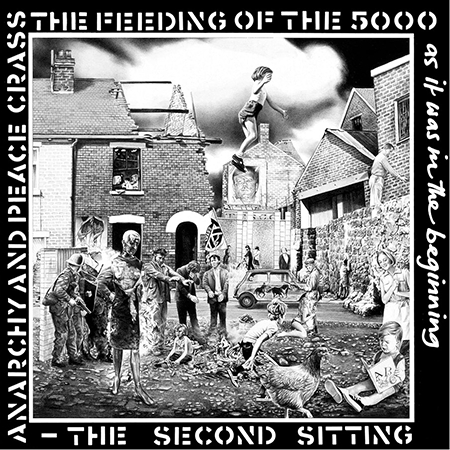Rebecca Binns, in her recent monograph focused on the seminal work of Gee Vaucher, Gee Vaucher: Beyond Punk, Feminism and the Avant-Garde, notes that Vaucher occupies a unique position in connecting avant-garde art movements, counterculture, punk and poetics (Binns 2023). Particularly associated with the anarchist punk collective and band Crass, Vaucher’s poetic and artistic work preceded and has succeeded the Crass vision, beginning in the early 1970s and continuing up until the present day, the work all the while evolving. As Binns notes, ‘While Vaucher rejects all ‘isms’, her work offers a unique take on the history of feminist art’ (Binns 2023). Primarily known as a visual artist, her work is of great interest in terms of poetic practice and political philosophy. Vaucher has an extensive range of work from the 1960s until the present. This includes working with members of the Fluxus art movement, paintings, film, collage, sculpture, design work, and extensive collaborations that have helped to facilitate and create Dial House, a collective home and anarchist free spirit arts space in Epping, Essex for nearly 50 years. Her work has also enjoyed a recent renaissance as speaking the truth back to power in terms of current global political turmoil.
All the Better to Eat You With, My Children!

Due to the collectivist nature of the Crass project, the seminal artwork produced for the band tended to be associated with the band as such (Berger 2006). However, it is hardly surprising that it was the male band members who came to the forefront of public attention, most notably Steve Ignorant (singer) and Penny Rimbaud (drummer). Nonetheless, what this occluded most especially was the inspiring work of the female artist Gee Vaucher, whose connection to Rimbaud went back to meeting at art college. Vaucher and Rimbaud also worked together on poetry and imagery for Crass and have continued to do so up until the present time. The unlikely pair of renegades had met at what was originally the South-East Essex Technical University and School of Art (aka Dagenham School of Art), located in a suburb of East London. Whereas Penny was a middle-class, public school educated drop-out, Gee was a working-class girl who got to art college on the strength of her teenage portfolio. The unique collage work of the vinyl sleeves was originally that of Vaucher and indeed her vision for the Crass project preceded the band in that her and Rimbaud were involved with the first squatting and takeover of the Dial House space in Essex in the late nineteen sixties, a place which was to become a paradigm of anarchist life in the UK thereafter (up until the present time). The May 1968 counter-cultural art and graffiti in Paris (and elsewhere) is a definite reference point. For example, the French Anarchist-Situationist poster in Figure No. 1 can be seen as directly connecting to Vaucher’s artistic but also poetic-philosophical style and semantics.
While this poster evinces a direct critique of capitalist ideology, there is also simultaneously a significant philosophical health warning from the Situationists which amounts to a self-satire. The dream of emancipation and the empowerment of the underclass may be just that, a dream. Perhaps all this talk of increasing radicalisation and democratisation is just another ruse to co-opt any potentially transformative action into complicity with the forces of power. This poster and this declaration also contain an angry and somewhat disillusioned question: What then would authentic participation in the revolution be, what would it look like? What could it possibly feel like in the real world beyond the spectacle? Is there even such a place? Vaucher’s art and poetics is haunted by the same admixture of hope and anxiety.
While it is easy to see Vaucher’s work exclusively in relation to protest art, it is more than that, particularly in how it employed ultra-realistic gouache painting techniques to affect a kind of Surrealist displacement. Vaucher’s work during the past twenty years has explored more personal themes, as well as the relationships between not only humans but also animals and humans. It is only recently that it has become possible to gain a fuller sense of the scope of Vaucher’s work through important and timely re-printing and re-releasing of some key materials that had been previously unavailable. Although famously low-key, Vaucher’s work first came to more mainstream public notice in the wake of Donald Trump’s first US presidential election victory. Her image, ‘Oh, America!’ (originally the cover for the Tackhead LP, Friendly as a Hand Grenade, 1989), appeared on the front cover of The Daily Mirror to illustrate post-election despair at the spectre of Trumpist politics in the ascendant. Who could foretell that by 2025 this horror-show spectacle would be on repeat? The music critic and digital creator John Robb reposted the Vaucher image this year in the wake of the re-election. Oh, how we all collectively gasped for air (and some meaning)!
Her work continues to reappear in the punk underground. The 2023 compilation album Cease & Resist - Sonic Subversion & Anarcho Punk In The UK 1979-86 employs several of her images, including ‘Oh, America’ and also (as cover) her collage of a warring (yet exhausted) soldier with rather incongruous female rouged lips superimposed, under the title Domestic Violence (Vaucher 1979; Optimo Records 2023).
Domestic Violence

But Vaucher’s original and iconoclastic artistic and poetic oeuvre goes all the way back to the late 1960s. In the 1970s, her work connected especially with anarchist and punk artists such as Jamie Reid and Linder Stirling. Reid’s cut-up and collage techniques (infamously identified with the Sex Pistols Never Mind the Bollocks cover art) were developed alongside (perhaps also in inspiration from) Vaucher’s seminal experiments with collage. Reid had also spent time in Paris with the anarchists in 1968, a seminal inspiration for his own cut-up and DIY techniques. These artistic methods also look back to cut-up literary techniques in earlier movements such as the Beats, especially the lateral methodology of William Burroughs. Reid and Vaucher were close friends and shared an anarchistic outlook, valuing personal and political autonomy rather than conventional structures (a theme of freedom that runs through each of their respective works).
Within the realm of art, another comparison is with the work of Manchester artist, Linder Sterling, who created cover art for early punk and new wave bands such as the Buzzcocks and Magazine, amongst others. Linder’s cover for the original single of Orgasm Addict by the Buzzcocks (framed as upside down) is another example of a striking originality and directness of approach. As female artists in an era of intense patriarchy, Linder and Vaucher’s work also demonstrates a kind of punk feminism (never purist but, all the more searingly, voicing women’s specific forms of oppression). In terms of bands within the punk movement who mirrored Vaucher’s ethics and politics, we could cite Slits, who were the first girl band to move beyond the female singer paradigm by having a group of girls playing their own instruments and writing their own songs. ‘Typical girls try to be / Typical girls very well, well’ (Slits, 1979). In philosophical terms, this specifically female work connects most particularly with early radical feminists such as Shulamith Firestone whose seminal text, The Dialectic of Sex: The Case for Feminist Revolution (Firestone 1970) was an incendiary emergent critique of patriarchal system and politics.
Feeding of the 5000

Vaucher’s work within Crass and Dial House helped to ferment and foster a DIY spirit in artistic performance and political organising. The anarcho-punk movement which originated (via the mutual vision of Vaucher and Rimbaud) with Crass and Dial House may have focused on politics and real-world action more than on aesthetics, but Vaucher’s work has its own artistic integrity.1 Her various covers for Crass develop her earlier collage work, and thematically connect her personal background with particular political critique addressed to the contemporary moment. The Feeding of the 5000 album cover from 1978 is perhaps the most powerful example of her poetics and aesthetic style.
Her cooperative and life-long relation to Penny Rimbaud is significant in this context. Real name Jeremy Ratter, Penny changed his name to invoke the great poet of French symbolism who advocated that we ‘change life’ but the Penny aspect referred to a more satirical aspect (a penny for his toilet philosophy). His very name change symbolizes the simultaneous light and serious sides of his work. As Vale notes, Rimbaud is a prolific writer and thinker; ‘Since the Sixties, Penny Rimbaud has written poetry, journals, prose, produced drawings, lectured and read poems aloud in dynamic performances (someone called him “the Allen Ginsberg of London” for producing an updated version of “Howl”, the poem that launched the Beat Generation)’. [Vaucher and Rimbaud 2016: 5]. But he is also, crucially for our purposes, the main conceptualist and lyricist (as well as the drummer, and a bloody good one) for Crass [Vaucher and Rimbaud 2016: 5].
Vaucher and Rimbaud’s mutual interviews with Vale are quite revealing on a number of levels [Vaucher and Rimbaud 2016], but, in a striking passage, Rimbaud articulates a rationale for the Crass project that goes beyond its conventional interpretation while also foregrounding Vaucher as an essential and prioritized element of the vision. Rimbaud claims that Crass were ‘strangely unique in the genre’ for two main reasons, first that ‘we meant what we said’ and second, that ‘what we said came from a much deeper force than it appeared to have’ [Vaucher and Rimbaud 2016: 120]. Strikingly, Rimbaud here cites a very particular example of the work of Gee Vaucher for Crass, the cover art for the Feeding of the 5000 album. His defence or affirmation of the specific contribution of Vaucher here is significant; ‘although it shows all the deprivations, the horrors, etc. of that era (which was the late Seventies) at the same time it projects through its love and its care, through its precision, through its beauty, something else’ [Vaucher and Rimbaud 2016: 120].
Rebecca Binns also notes this as a particularly iconic image of Vaucher’s (Binns 2023: 8), connecting it to the gritty and monochrome ‘declinist’ aesthetic of punk design. ‘Vaucher’s illustrations from this time often juxtapose children playing in the rubble with newsreel imagery depicting contemporary political events’ (Binns 2023: 9). We can remember here that Vaucher’s own childhood was that of playing amongst the bombed-out buildings of East London, post-World War II. But this particular canvas (originally a painting by Vaucher) contrasts here, in 1978, the bombed-out buildings with the depiction of new houses under construction. Moreover, the serious boy in the foreground reading is contrasted with the children playing less seriously in the bombed-out buildings. Perhaps the most striking aspect of the canvas is the image of the child figure, suspended above the architecture. On a meta-level, the overall sense of the canvas is an affirmative one. The setting is depicted as providing possibilities for liberation rather than just being symptomatic of economic and social deprivation. Vaucher notes, ’the one that’s in the air is the freest one. So, she’s the figure of hope. She’s in isolation. She’s flying there. She’s a modern-day fairy if you like’ (quoted Binns 2023: 10).
Still Life With Nude
The soldier’s favourites up front
in a kind of battlefield nest,
his family portraits and a brunette
with pert tits surrounded by used
bullets – and in the background,
this soldier’s dead body prostrate.
Gee Vaucher Haiku
As Shulamith says,
Girls gotta be extra careful
Not to self-defeat.
Gee ain’t no typical girl;
Lucky her, with a mother
Who could adore the daughter.
Playing in the bombed-out
Post-War sites of Barking,
Her vision started working.
Then she met Penny.
Drew mashed up Tory
Scenes for Crass vinyl sleeves,
Anticipated the Trump meta-crises.
Oh, America hides its eyes,
While the rest of the world dies.
But rising up, still here,
Today her neo-feminist ire
Sketches a refigured future.
Hail our hero Vaucher!
Footnote
1.Alongside the more full-frontal lyrics of Crass, Conflict, et al, other bands and figures developed a more enigmatic approach to related topics of world crisis and political evil. Notable here is the artist Nick Blinko, who, as lead singer and lyricist with the band Rudimentary Peni, has created some of the most extraordinary poetics and prose of the movement. Artistically his work is recognized internationally as part of what is called ‘Outsider Art’. ‘Outsider Art is the creative visual work produced by a rich and varied group of individuals who do not fit into the official category of professional artist. At its best, it renders visible, powerfully and directly, a kind of psychic elsewhere’ (Rhodes 2000: 6). Blinko’s lyrics are another example of punk poetics, in this unique case channelled through a neo-gothic vision which has a strong influence of writers such as Lord Dunsany and H.P. Lovecraft.
Figures
1.All the Better to Eat You With, My Children!, Vermès & Kugelberg (2011: 6).
2.Domestic Violence, Gee Vaucher (1979).
3.Feeding of the 5000, Gee Vaucher (1978).
These images are believed to have been intentionally created without any assertion of copyright.
References
Berger, George (2006) The Story of Crass. Omnibus Press, London.
Binns, Rebecca (2023) Gee Vaucher: Beyond Punk, Feminism and the Avant-Garde. Manchester University Press, Manchester.
Blinko, Nick (2011) The Primal Screamer. PM Press, London.
Conflict (1986) The Ungovernable Force. Mortarhate Records, London.
Crass (1986). Best Before 1984. Crass Records, London.
Firestone, Shulamith (1970) The Dialectic of Sex: The Case for Feminist Revolution. Farrar, Strauss and Giroux, New York.
Irwin, Jones (2020) ‘The posters of May ‘68 and their significance for a contemporary critique of Capitalism’. Estudios de Filosofía (Universidad de Antioquia) 62 (2020), Chile.
Irwin, Jones (2025) Deep Image. Tofu Ink Press, California.
Lewis, Jeffrey (2007) 12 Crass Songs. Rough Trade, London.
Rudimentary Peni (1988) Cacophony. Outer Himalayan Records, London.
Sladen, Mark and Yedgar, Ariella (2007) Panic Attack! Art in the Punk Years. Barbican Gallery, London.
Various (2023) Cease & Resist - Sonic Subversion & Anarcho Punk In The UK 1979-86. Optimo Records, Glasgow.
Vaucher, Gee and Rimbaud, Penny (2016) Interviews by V. Vale. RE-SEARCH, San Francisco.
Vermès, P. & Kugelberg, J. (2011) La beauté est dans la rue. Beauty Is In The Street. A Visual Record of the May ‘68 Paris Uprising. Four Corners Books, London.